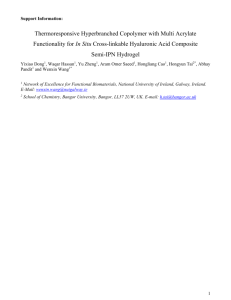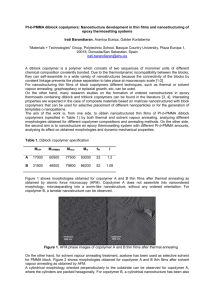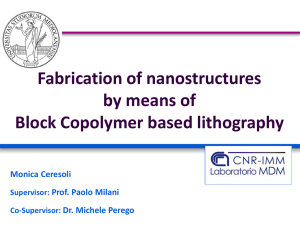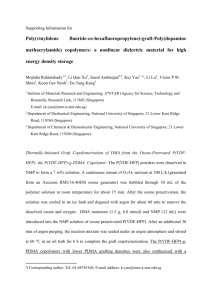Supplementary Information (doc 282K)
advertisement
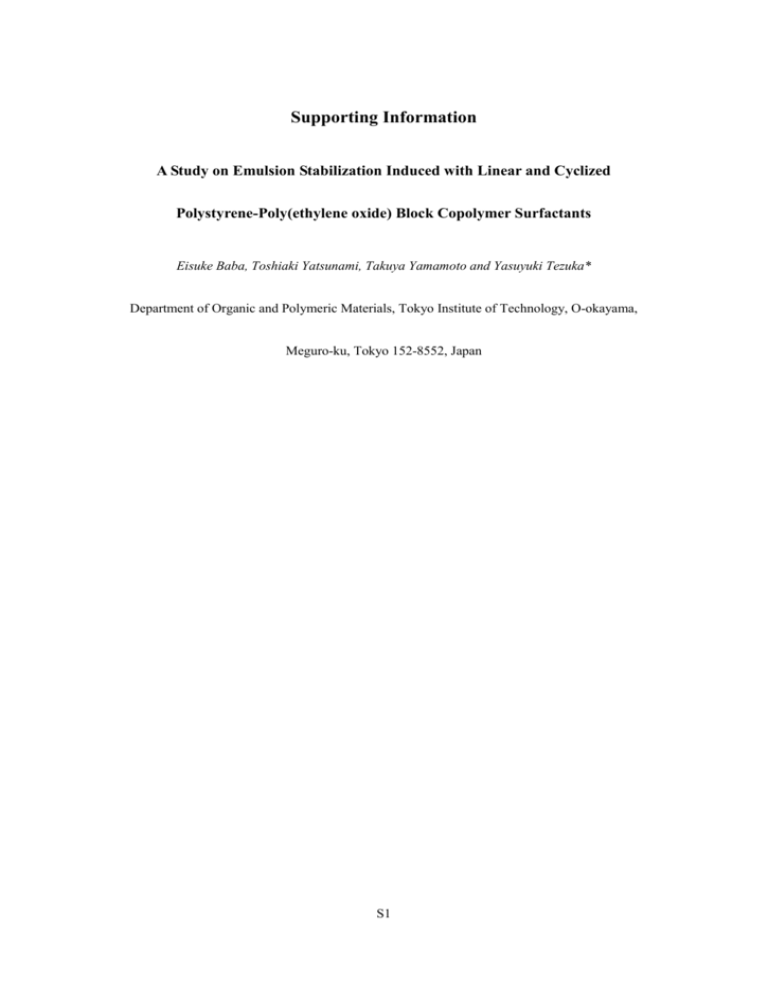
Supporting Information A Study on Emulsion Stabilization Induced with Linear and Cyclized Polystyrene-Poly(ethylene oxide) Block Copolymer Surfactants Eisuke Baba, Toshiaki Yatsunami, Takuya Yamamoto and Yasuyuki Tezuka* Department of Organic and Polymeric Materials, Tokyo Institute of Technology, O-okayama, Meguro-ku, Tokyo 152-8552, Japan S1 EXPERIMENTAL PROCEDURES Reagents Poly(ethylene oxide), PEO, macroinitiator having 2-bromoisobutyryl terminal groups (Mn(NMR) = 2300) was prepared by the esterification of poly(ethylene oxide) (Mn = 2000, Aldrich) with α-bromoisobutyryl bromide (98%, Aldrich) in the presence of triethylamine (99%, Kanto Chemical Co., Inc.) as reported previously.1,2 Styrene (99%, Nacalai Tesque, Inc.) was purified through alumina column to remove polymerization inhibiter. The reagents for the preparation of a block copolymer, i.e., CuBr (99%, Nacalai Tesque, Inc.), N,N,N',N'',N''-Pentamethyldiethylenetriamine (PMDETA) (98%, TCI), allyltrimethylsilane (98%, Aldrich) and TiCl4 (99%, Nacalai Tesque, Inc.) were used as received. The solvent for the allylation reaction (CH2Cl2, 99%, Kanto Chemical Co., Inc.) was distilled over CaH2 before use. The reagents for the cyclization reaction, i.e. Hoveyda-Grubbs catalyst 2nd generation (Aldrich), ethyl vinyl ether (99%, Aldrich), toluene (99%, Kanto Chemical Co., Inc.) and activated alumina (300 mesh, Wako Pore Chemical Industries, Ltd.) were used as received. For the emulsion stabilization experiments, toluene (99%, Kanto Chemical Co., Inc.) was used as received, while water was distilled before use. S2 Synthesis of a linear PS-PEO-PS block copolymer having allyl end groups (1)3,4,5 A weighed amount of the PEO macroinitiator (979 mg, 0.404 mmol), styrene (9.5 mL, 83 mmol), CuBr (170 mg, 1.2 mmol) and PMDETA (0.26 mL, 0.12 mmol) were placed in a 30 mL flask. After the flask was degassed by freeze-pump-thaw cycles, the polymerization reaction of styrene was allowed to proceed under stirring for 3.5 h at 90 °C. The solidified mixture was then dissolved in CHCl3 and poured into methanol to recover the precipitated product, which was again dissolved in CHCl3 for the treatment of a plug of alumina to remove the catalyst residue. The eluted product solution was concentrated and poured into methanol to obtain the PS-PEO-PS block copolymer product having bromoalkyl end groups as a white solid precipitate (3.72 g, 82% yield). Thereafter, a part of the product (990 mg, 89 mol) was dissolved in CH2Cl2 (0.8 mL), and allyltrimethylsilane (1.25 mL, 11.4 mmol) and TiCl4 (1.25 mL, 7.87 mmol) were added. After the reaction under stirring for 30 min at room temperature, methanol was added to quench the reaction. The crude product was recovered after the concentration and the subsequent precipitation into methanol as a white solid (787 mg, 77% yield). The product having allyl end groups (1) was finally isolated by means of the preparative SEC fractionation (CHCl3 as an eluent at a flow rate of 3.5 ml min–1) in the yield of 463 mg. S3 1 H NMR (Figure S1, top): δ (ppm) 0.79-1.08 (m, CH3) 1.08-2.58 (m, -CH2CH(Ph)-, -CH2CH(Ph)-), 3.29-3.95 (m, -OCH2-) 4.72-4.96 (m, -CH2CH=CH2), 5.36-5.61 (m, -CH2CH=CH2), 6.30-7.38 (m, -CH2CH(C6H5)-). Mn (NMR) = 4100-2100-4100, SEC (Figure S2, top): Mp (peak MW) = 15000, PDI = 1.13. Synthesis of a cyclized PS-PEO block copolymer (2)3 Into a 1 L toluene solution containing a weighed amount of 1 (200 mg, 18.8 µmol), Hoveyda-Grubbs 2nd generation catalyst (60 mg, 95 µmol) was added to proceed the reaction under stirring for 21 h at 70 °C. Ethyl vinyl ether (10 mL) was then added to the mixture to deactivate the catalyst under stirring for 30 min at 70 °C. The cyclized PS-PEO block copolymer product (2) was isolated after the precipitation into methanol as a pale brown solid (123 mg, 59% yield). 1 H NMR (Figure S1, bottom): δ (ppm) 0.80-1.09 (m, CH3) 1.09-2.56 (m, -CH2CH(Ph)-, -CH2CH(Ph)-), 3.29-3.99 (m, -OCH2-) 4.69-4.95 (m, -CH=CH), 6.29-7.42 (m, -CH2CH(C6H5)-). Mn(NMR) = 8900-2100, SEC (Figure S2, bottom): Mp (peak MW) = 12000, PDI = 1.10. Measurements 1 H NMR spectra were recorded on a JEOL JNM-AL300 spectrometer operating at S4 300 MHz using CDCl3 as a solvent. Proton chemical shifts were reported relative to the signal of tetramethylsilane. SEC measurements were performed on a Tosoh model CCPS equipped with a refractive index detector model RI 8020 and a TSK G3000HXL column equilibrated at 40 °C. THF was used as an eluent at a flow rate of 1.0 mL/min. A set of linear PS standards were used for calibration, and the peak molecular weight (Mp) of polymer samples were reported as a linear PS equivalent. References 1. Adachi, K.; Honda, S.; Hayashi, S.; Tezuka, Y. Macromolecules 2008, 41, 7898–7903. 2. Hayashi, S.; Adachi, K.; Tezuka, Y. 3. Chem. Lett. 2007, 36, 982–983. Baba, E.; Honda, S.; Yamamoto, T.; Tezuka, Y. Polym. Chem. 2012, 3, 1903–1909. 4. Fonagy, T.; Schulze, U.; Komber, H.; Voigt, D.; Pionteck, J.; Ivan, B.; Macromolecules 2007, 40, 1401–1407. 5. Schulze, U.; Fonagy, T.; Komber, H.; Pompe, G.; Pionteck, J.; Ivan, B.; Macromolecules, 2003, 36, 4719–4726. S5 Figure S1: 300 MHz 1H NMR spectra of (top) a linear PS-PEO-PS block copolymer having allyl end groups (1) and (bottom) a cyclized PS-PEO block copolymer (2) (CDCl3, r.t.) S6 Figure S2: SEC traces of (top) a linear PS-PEO-PS block copolymer having allyl end groups (1) and (bottom) a cyclized PS-PEO block copolymer (2) (THF as an eluent, 1.0 mL/min) S7 Figure S3: Time dependence (up to 30 min) of the volume ratio of the separated water layer from the water phase emulsion in the presence of (left) a linear PS-PEO-PS block copolymer (1) and (right) a cyclized PS-PEO block copolymer (2) (the initial surfactant concentration of 0.2 g/L in toluene) at toluene/water ratio of 10/15 (mL/mL), and at 50 o C. The emulsion was formed by shaking the sample solution in a glass cylinder either by 10, 100 or 200 times in about 1 min. S8 Figure S4: Time dependence of the volume ratio of the separated water layer from the water phase emulsion in the presence of (left) a linear PS-PEO-PS block copolymer (1) and (right) a cyclized PS-PEO block copolymer (2) (the initial surfactant concentration of 0.1 g/L in toluene) at toluene/water ratio of 10/10 (mL/mL), and at 50 oC. A set of five experiments (○,△,□ and ●) were conducted by using separately prepared samples and the average of the medium three (○,△,□) was used to represent the results in Figures 2 and 3. S9 Figure S5: Time dependence of the volume ratio of the separated toluene layer from the toluene phase emulsion in the presence of (●,▲,■) a linear PS-PEO-PS block copolymer (1) and (○,△,□) a cyclized PS-PEO block copolymer (2) (the initial surfactant concentration of 0.1 g/L in toluene) at toluene/water ratio of 10/10 (mL/mL), and at 25 (● and ○), 50 (▲ and △) and 75 oC (■ and □). S10
